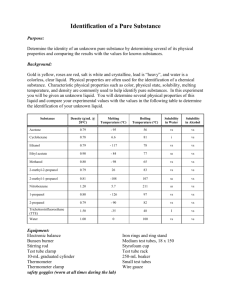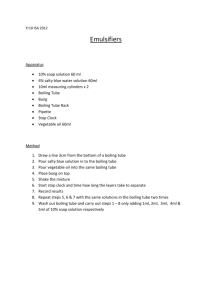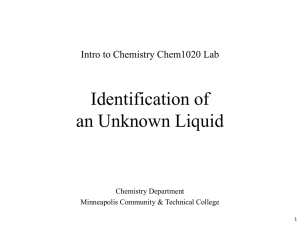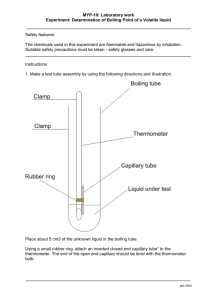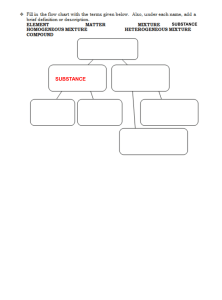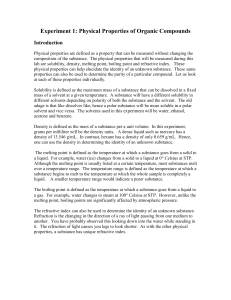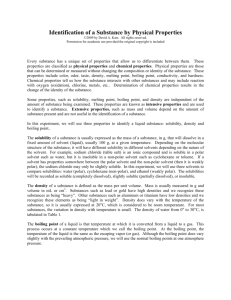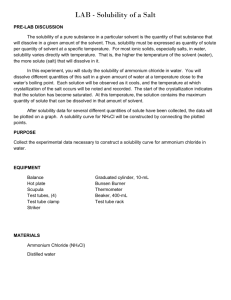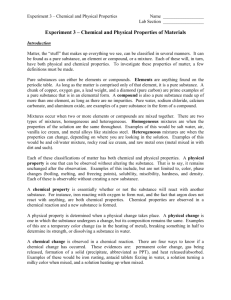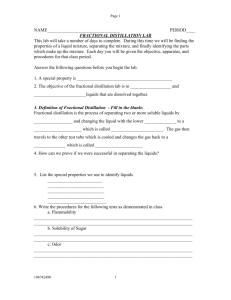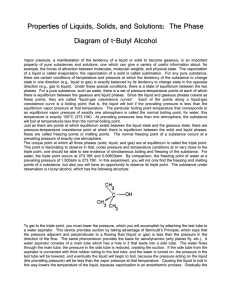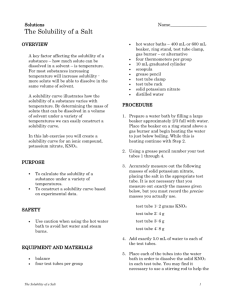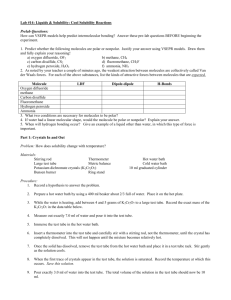Identification of a Pure Substance
advertisement
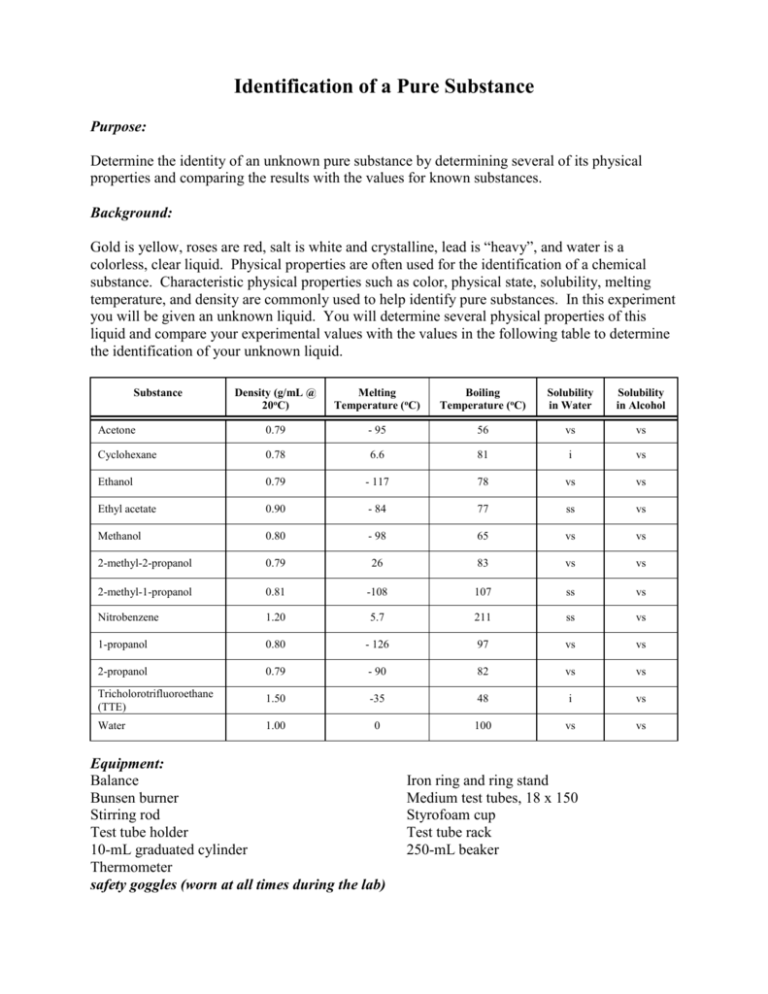
Identification of a Pure Substance Purpose: Determine the identity of an unknown pure substance by determining several of its physical properties and comparing the results with the values for known substances. Background: Gold is yellow, roses are red, salt is white and crystalline, lead is “heavy”, and water is a colorless, clear liquid. Physical properties are often used for the identification of a chemical substance. Characteristic physical properties such as color, physical state, solubility, melting temperature, and density are commonly used to help identify pure substances. In this experiment you will be given an unknown liquid. You will determine several physical properties of this liquid and compare your experimental values with the values in the following table to determine the identification of your unknown liquid. Substance Density (g/mL @ 20oC) Melting Temperature (oC) Boiling Temperature (oC) Solubility in Water Solubility in Alcohol Acetone 0.79 - 95 56 vs vs Cyclohexane 0.78 6.6 81 i vs Ethanol 0.79 - 117 78 vs vs Ethyl acetate 0.90 - 84 77 ss vs Methanol 0.80 - 98 65 vs vs 2-methyl-2-propanol 0.79 26 83 vs vs 2-methyl-1-propanol 0.81 -108 107 ss vs Nitrobenzene 1.20 5.7 211 ss vs 1-propanol 0.80 - 126 97 vs vs 2-propanol 0.79 - 90 82 vs vs Tricholorotrifluoroethane (TTE) 1.50 -35 48 i vs Water 1.00 0 100 vs vs Equipment: Balance Bunsen burner Stirring rod Test tube holder 10-mL graduated cylinder Thermometer safety goggles (worn at all times during the lab) Iron ring and ring stand Medium test tubes, 18 x 150 Styrofoam cup Test tube rack 250-mL beaker Materials: Unknown liquid Distilled water Boiling chip Ice Procedure: Part One Density Tare a clean, dry 10 mL graduated cylinder on the electronic balance. Add 10 mL of your unknown liquid to the graduated cylinder. Use a micropipet to adjust the volume. Record the volume of the liquid in the graduated cylinder to the nearest 0.1 mL. Weigh the graduated cylinder and your unknown liquid to the nearest 0.01 gram. Calculate the density of the unknown liquid. Record the density of the unknown liquid. Return the liquid to the sample container for the other determinations. Part Two Solubility in Water The solubility of a substance depends upon temperature. Solubility can be expressed as grams of solute per 100 grams of solvent for a specified temperature. Your solubility tests will be less quantitative and will be reported simply as very soluble (vs), slightly soluble (ss), or insoluble (i). Using a clean medicine dropper, add 20 drops of water to a medium test tube. Use the micropipet to add 20 drops of the unknown, 2 or 3 drops at a time, shaking the tube after each addition. If all of the drops mix completely forming a single phase, the substance is very soluble. If, after the first few drops the unknown does not seem to dissolve but forms two layers, the substance is said to be insoluble. If at first a few drops seem to dissolve but later two layers form as more is added, the substance is said to be slightly soluble. Record your results. Part Three Solubility in Alcohol Repeat the procedure used in part two of this experiment substituting isopropyl alcohol as the solvent. Record your results. Part Four Melting or Freezing Temperature The temperature at which the liquid and solid phases of a substance are both present is called its melting or freezing temperature. Measure about 10 mL of the unknown substance into a clean, dry medium test tube. Clamp the test tube on a ring stand and place a thermometer into the liquid. Obtain an ice-slush mixture in a styrofoam cup. Lower the test tube into the ice bath and continuously monitor the temperature. Stir the liquid gently with the thermometer. Note the time and temperature when crystals first appear. Continue to monitor the temperature and record the freezing temperature based upon your observations of crystal formation and constant temperature. If the liquid does not begin to form crystals by the time the temperature has become nearly zero, 2 record the freezing temperature to be below 0oC. If the liquid did freeze, record the freezing temperature when the temperature remained relatively constant as the crystals formed. Leave the thermometer in the test tube. Save the entire system for the boiling temperature measurement. Part Five Boiling Temperature Add a boiling chip to the unknown liquid in the test tube. Half-fill a 250 mL beaker with tap water and place it on a wire gauze on a ring stand. Lower the test tube into the beaker of water and slowly begin heating the water with a Bunsen flame. CAUTION: Keep the burner flame away from the mouth of the test tube. The unknown may be flammable. Continuously monitor the temperature and note the temperature when the liquid first starts to boil. Continue to take monitor the temperature until a constant boiling temperature is observed. Stop heating the water bath and remove the test tube from the water bath. Return any remaining unknown liquid to the original vial and hand in to Mr. Gensits. If your unknown does not boil by the time the tap water starts boiling, stop heating, remove the test tube from the hot water, and record the boiling temperature to be greater than 100oC. If the liquid did boil, record the boiling temperature when the temperature remained relatively constant as the liquid boiled. Part Six Identifying the Unknown Using the physical properties determined from your unknown substance, choose the substance listed in the table on page one of the experiment which best fits the data. Account for any differences in the listed data and your experimentally determined values. (Note: In the table densities are given @ 20oC and the boiling temperatures are measured for 1 atmosphere pressure.) 3
